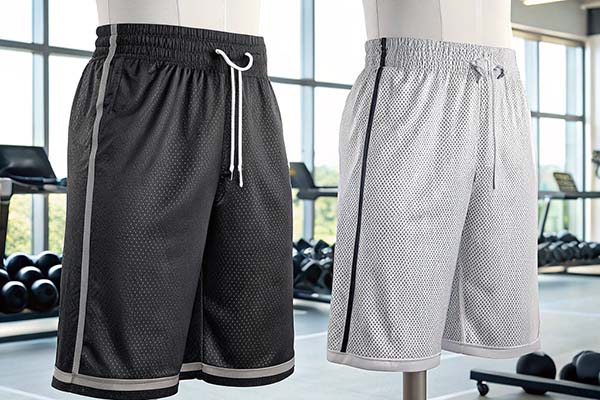When choosing the perfect pair of shorts for your workout or daily activities, one question often arises: Should you go with lined or unlined shorts? Each type offers unique benefits, and the best choice depends on your preferences, activity level, and comfort needs.
Lined shorts are better for high-intensity activities, offering support, moisture-wicking1, and chafing prevention2. Unlined shorts provide flexibility for casual wear or pairing with compression layers3, making them ideal for those who prefer customization.
In this article, we’ll break down the pros and cons of lined and unlined shorts, their ideal uses, and how to choose the right type for your lifestyle.

What Are Lined Shorts?
Lined shorts have a built-in inner layer, typically made of lightweight and stretchy material. This liner functions like underwear or compression shorts, offering support and moisture management.
Advantages of Lined Shorts
-
Built-In Support
- Acts as a secure layer to keep everything in place during movement.
- Eliminates the need for additional undergarments, simplifying your gear.
-
Chafing Prevention
- Smooth liner fabric reduces skin friction, preventing irritation during extended activities.
-
Moisture-Wicking
- The liner helps pull sweat away from the skin, keeping you dry and comfortable.
-
Convenience
- All-in-one design reduces bulk and eliminates the hassle of pairing shorts with separate layers.
Best Uses for Lined Shorts
Lined shorts are ideal for activities requiring support and high performance, including:
- Running
- Cycling
- CrossFit
- HIIT workouts
What Are Unlined Shorts?
Unlined shorts have no inner layer, offering a more traditional design. They rely on the wearer to pair them with their choice of undergarments or compression layers.

Advantages of Unlined Shorts
-
Customizable Layers
- Gives you the flexibility to choose your preferred base layer, such as boxers or compression shorts.
-
Breathability
- Without a liner, unlined shorts provide maximum airflow, making them great for hot weather.
-
Versatility
- Easily transition from gym wear to casual attire.
-
Freedom of Movement
- Some people find unlined shorts less restrictive compared to lined options.
Best Uses for Unlined Shorts
Unlined shorts work well for casual or low-intensity activities, including:
- Weightlifting
- Lounging
- Light jogging
- Everyday wear
Comparing Lined and Unlined Shorts
| Feature | Lined Shorts | Unlined Shorts |
|---|---|---|
| Support | Built-in, secure layer | Depends on paired base layer |
| Chafing Prevention | Excellent | Varies based on undergarment choice |
| Moisture Management | Superior | Relies on chosen base layer |
| Convenience | All-in-one design | Requires additional layers |
| Flexibility | Slightly restrictive for some activities | Fully customizable |
| Best For | High-intensity activities | Casual or low-intensity activities |
How to Choose Between Lined and Unlined Shorts
The decision between lined and unlined shorts boils down to your activity level, comfort preferences, and specific needs. Here are some key factors to consider:

1. Activity Type
- For Running or HIIT: Choose lined shorts for their built-in support and chafing prevention.
- For Weightlifting or Casual Wear: Opt for unlined shorts to pair with your favorite compression shorts or boxers.
2. Comfort Preferences
- If you prefer a minimalist design, lined shorts offer a hassle-free option.
- If you like customizing your layers, unlined shorts provide more flexibility.
3. Climate
- Hot Weather: Unlined shorts allow for better airflow.
- Humid or Intense Workouts: Lined shorts wick moisture and prevent discomfort.
Dive Deeper: Key Features to Look for in Both Types
Whether you choose lined or unlined shorts, pay attention to these features for maximum performance and comfort:
1. Fabric
- Moisture-Wicking: Polyester and nylon are ideal for sweat management.
- Breathable Mesh Panels: Enhance airflow for better cooling.
2. Fit
- Lined Shorts: Look for a snug but non-restrictive liner.
- Unlined Shorts: Ensure a loose, comfortable outer fit to pair well with base layers.
3. Length
- Short Inseams (1-3 inches): Best for runners seeking mobility.
- Medium Inseams (4-6 inches): Versatile for various activities.
- Long Inseams (7+ inches): Preferred for modesty and added coverage.
Caring for Your Shorts
Proper care ensures your shorts remain functional and comfortable:
- Wash in Cold Water: Preserves fabric integrity and moisture-wicking properties.
- Avoid Fabric Softeners: They can reduce breathability.
- Air Dry: Prevents shrinking and maintains elasticity.
Popular Brands for Lined and Unlined Shorts
Here are some trusted brands offering both lined and unlined shorts:
- Nike: Known for moisture-wicking lined shorts with Dri-FIT technology4.
- Adidas: Offers versatile options with breathable fabrics5.
- Lululemon: Combines luxury and performance for both styles.
- Under Armour: Focuses on support and durability in their designs.
- Patagonia: Features eco-friendly and sustainable materials.
Conclusion
Both lined and unlined shorts have their advantages, and the best choice depends on your specific needs. Lined shorts are perfect for high-intensity activities, offering built-in support and moisture-wicking capabilities. Unlined shorts provide versatility and customization, making them great for casual wear or layering. By considering your activity level, comfort preferences, and climate, you can find the perfect pair to suit your lifestyle and keep you performing at your best.
-
Understanding moisture-wicking benefits ensures better performance and comfort. ↩
-
Reducing skin friction enhances comfort and prevents workout injuries. ↩
-
Discovering layer benefits boosts performance and offers customizable support. ↩
-
Exploring advanced fabric tech helps maximize moisture management advantages. ↩
-
Selecting airy textiles maintains cooler body temperatures and reduces sweat. ↩













